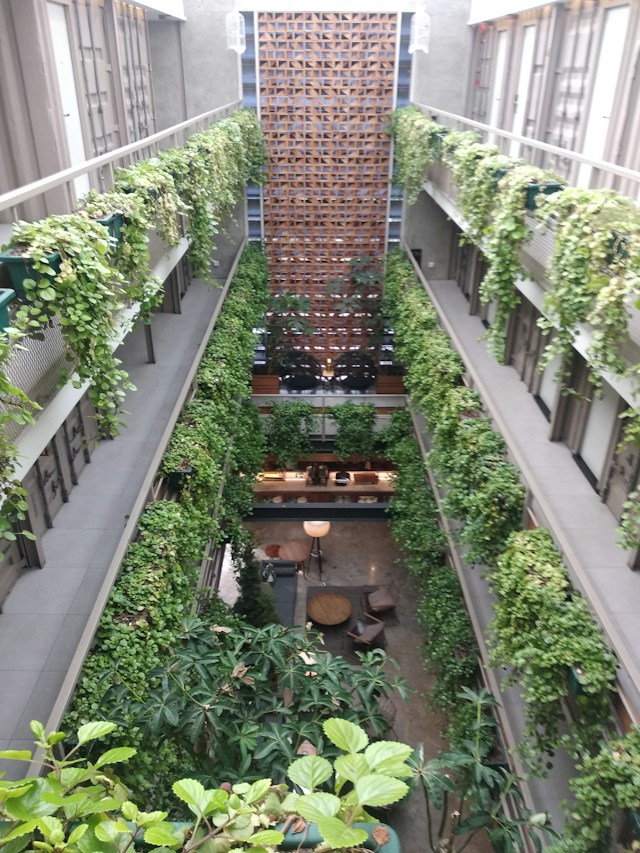How to create a vertical garden at home

In today’s bustling world, greenery often acts as a sanctuary. Gardening is a retreat for many, offering a sense of tranquility and satisfaction. However, not everyone has the luxury of expansive outdoor spaces to cultivate. The good news is, with just a bit of innovation and an eager green thumb, you can bring this solace into your living space, no matter how small. Enter the world of vertical gardens.
The Basics of Vertical Gardening
Vertical gardening is an innovative, space-efficient way to grow plants, where you use the vertical space of walls or structures instead of the typical horizontal gardening. This method is not only a practical solution for small spaces, but it also adds a unique aesthetic appeal to your home.
Lire également : Personalizing your bedroom
Before we delve into this guide, it’s important to understand the basic requirements of a vertical garden. Just like any other garden, it requires suitable plants, appropriate sunlight, and efficient watering system. The difference lies in its spatial configuration, as its structure can vary from freestanding installations to wall-mounted frames.
Choosing the Right Plants
The selection of plants is crucial for the success of a vertical garden. The choice depends on the light conditions and the climate of your location. Succulents, ferns, and ivy are common choices for vertical gardens due to their adaptability and low maintenance.
A voir aussi : Home safety: essential tips
When choosing your plants, consider their growth habits. Select plants that naturally grow upwards and avoid those with sprawling, horizontal growth patterns. It’s also advisable to choose plants with similar light and water requirements to ensure they all thrive in the same environment.
Building the Vertical Garden Structure
Building a structure for your vertical garden can be an enjoyable DIY project. You can construct it from a variety of materials like wood, metal, or plastic. The structure needs to be sturdy enough to hold the weight of the plants, soil, and water.
A simple structure design involves attaching a series of containers or planters to a vertical frame. These containers can be pots, plastic bottles, or fabric pockets, depending on your aesthetic preference and budget. Ensure the containers have proper drainage to prevent water accumulation and root rot.
Setting Up the Irrigation System
A crucial aspect of maintaining a vertical garden is its irrigation system. The challenge lies in ensuring that all plants receive an adequate amount of water, despite their vertical arrangement. Drip irrigation or self-watering systems are commonly used for these gardens.
Drip irrigation involves setting up a network of tubes that deliver water directly to the root zone of each plant. Self-watering systems, on the other hand, have a reservoir at the bottom of the structure that holds water. The plants absorb the water through capillary action. An efficient irrigation system will help maintain the health of your plants and reduce the manual effort involved in watering.
Choosing the Right Location
The location of your vertical garden is dependent on the light requirements of your chosen plants. If your plants need full sun, an outdoor wall that receives plenty of sunlight would be ideal. For shade-loving plants, an indoor location with indirect light would work best.
Consider the weight of the fully watered garden when choosing the location. If you’re mounting it on a wall, ensure the wall is capable of bearing the weight. For freestanding installations, ensure the surface below is sturdy and levelled.
Maintaining Your Vertical Garden
Regular maintenance is key to the longevity and visual appeal of your vertical garden. This involves regular watering, timely pruning, and periodic fertilization.
Frequent inspection of your plants for pests and diseases is essential. Early detection and treatment can prevent the spread of these issues to other plants. Also, over time, some plants may outgrow their space or overshadow the others. Regular pruning will help manage the growth and ensure that all plants receive adequate light.
Vertical gardening is a journey that brings you closer to nature, transforming your living space into a green oasis. It offers a new perspective to gardening, where the sky is literally the limit. With these guidelines, you’re now equipped to embark on this journey and create your very own vertical garden at home.
Incorporating Technology in Vertical Gardening
In our tech-savvy world, it’s no surprise that gardening has also embraced the digital age. There are various ways to incorporate technology in your vertical garden to make it more efficient and easier to maintain.
There are smart irrigation systems that can be programmed to water your plants at specific intervals. These systems are designed to conserve water and ensure that each plant gets the precise amount of water it needs. You can even control them remotely using your smartphone.
Grow lights also come in handy, especially in indoor vertical gardens where sunlight might be insufficient. These are special lights that mimic the natural light spectrum, promoting plant growth no matter the time of day. They are energy-efficient and can be customized to the specific needs of your plants.
Furthermore, technology can assist in monitoring the health of your plants. There are sensors that can measure elements like soil moisture, light levels, and temperature. These devices can alert you when the plants need attention, thus making maintenance a breeze.
For those who prefer to be hands-off in their gardening, there are vertical gardening kits. These come with everything you need, including a self-watering feature, sturdy frames, and even pre-planted seed pods. They also come with instructions that make the process straightforward and easy for beginners.
Incorporating technology really does simplify the process of maintaining a vertical garden and enhances its productivity. It allows you to enjoy the benefits of gardening, even with a busy schedule.
Conclusion
Creating a vertical garden at home is a delightful enterprise that transforms limited spaces into a dynamic and vibrant sanctuary. It’s an innovative way to cultivate plants and bring greenery into your living space.
Choosing the right plants, building a sturdy structure, selecting the ideal location, and setting up an efficient irrigation system are just some of the steps in this process. Regular maintenance ensures the longevity and visual appeal of your vertical garden.
Incorporating technology can also greatly assist in managing your garden. From smart irrigation systems to grow lights and digital sensors, there are numerous gadgets that can help maintain the health of your plants while cutting down on the manual effort.
Vertical gardening is truly a unique and rewarding experience. It’s a testament to human creativity, showing that even in the most restricted of spaces, nature can flourish. It’s not just a trendy form of gardening; it’s an environmental solution, a statement, and an art form.
As you embark on this journey of vertical gardening, remember that patience is key. It might take time for your green wall to flourish, but once it does, the lush greenery will be a sight for sore eyes. So go ahead, roll up your sleeves, and create your unique slice of paradise at home.
